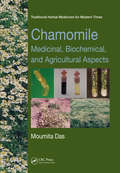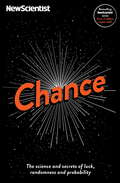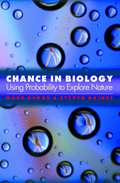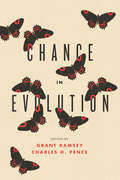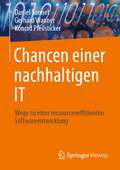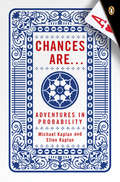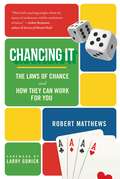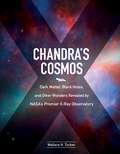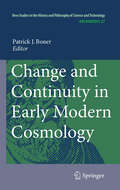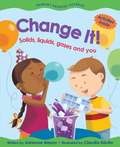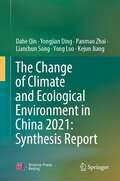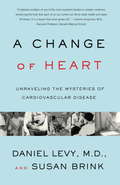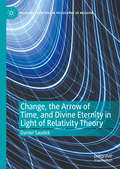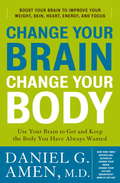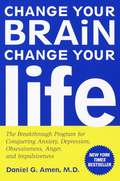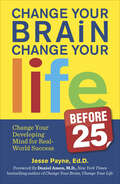- Table View
- List View
Chamomile: Medicinal, Biochemical, and Agricultural Aspects (Traditional Herbal Medicines for Modern Times)
by Moumita DasIn use as a medicinal plant since time immemorial in Europe and the Middle East, chamomile is gaining popularity in the Americas, Australia, and Asia. The spectrum of disease conditions in which it is used in traditional medicine systems is, quite simply, mind boggling. There is, without a doubt, a growing demand for this plant and therefore a grow
Chamomile: Industrial Profiles
by Rolf Franke Heinz SchilcherFor over 2000 years, preparations of chamomile flowers have counted among the medicinal treasures of many cultural groups. This book provides an interdisciplinary inventory of the scientific level of knowledge about German chamomile as well as Roman chamomile, the two types of chamomile most produced. It includes information for pharmacists and the
Chance: The science and secrets of luck, randomness and probability (New Scientist Ser.)
by New ScientistFor you to be here today reading this requires a mind-boggling series of lucky breaks, starting with the Big Bang and ending in your own conception. So it's not surprising that we persist in thinking that we're in with a chance, whether we're playing the lottery or working out the likelihood of extra-terrestrial life. In Chance, a (not entirely) random selection of the New Scientist's sharpest minds provide fascinating insights into luck, randomness, risk and probability. From the secrets of coincidence to placing the perfect bet, the science of random number generation to the surprisingly haphazard decisions of criminal juries, it explores these and many other tantalising questions.Following on from the bestselling Nothing and Question Everything, this book will open your eyes to the weird and wonderful world of chance - and help you see when some things, in fact, aren't random at all.
A Chance for Lasting Survival
by David Garshelis Wang Dajun Richard B. Harris William J. Mcshea Pan WenshiFrom 1984 through 1995 a small band of ecologists led by Pan Wenshi from Peking University conducted a study of wild giant pandas in the Qinling Mountains of Shaanxi Province. This project was the first Chinese-led conservation project in China and was conducted during a significant transition period in Chinese history, as the country opened its society and science to the world. The project focused on behavioral observation of wild giant pandas, but evolved to include physiology, nutrition, ecology, land-use policy, and population biology as the staff became more aware that the issues with captive pandas (assisted reproduction, unusual diet, and genetic inbreeding) were not the most critical to survival of wild populations. It is evident in this work that, as the scientists gained knowledge, they came to see giant panda conservation as wrapped in landscape ecology and human/wildlife interactions. The group was seminal in the Chinese government's enactment of a logging ban to their study area by advocating for pandas at the national level. The project was summarized in a 2001 volume, but its publication in Mandarin limited its influence on the greater conservation community. This English version of the original work translates, condenses, and refines the original volume, with added contextual chapters on the importance of this volume and how our understanding of giant panda conservation is shaped by this pioneering field work.
Chance in Biology: Using Probability to Explore Nature
by Mark Denny Steven GainesLife is a chancy proposition: from the movement of molecules to the age at which we die, chance plays a key role in the natural world. Traditionally, biologists have viewed the inevitable "noise" of life as an unfortunate complication. The authors of this book, however, treat random processes as a benefit. In this introduction to chance in biology, Mark Denny and Steven Gaines help readers to apply the probability theory needed to make sense of chance events--using examples from ocean waves to spiderwebs, in fields ranging from molecular mechanics to evolution. Through the application of probability theory, Denny and Gaines make predictions about how plants and animals work in a stochastic universe. Is it possible to pack a variety of ion channels into a cell membrane and have each operate at near-peak flow? Why are our arteries rubbery? The concept of a random walk provides the necessary insight. Is there an absolute upper limit to human life span? Could the sound of a cocktail party burst your eardrums? The statistics of extremes allows us to make the appropriate calculations. How long must you wait to see the detail in a moonlit landscape? Can you hear the noise of individual molecules? The authors provide answers to these and many other questions. After an introduction to the basic statistical methods to be used in this book, the authors emphasize the application of probability theory to biology rather than the details of the theory itself. Readers with an introductory background in calculus will be able to follow the reasoning, and sets of problems, together with their solutions, are offered to reinforce concepts. The use of real-world examples, numerous illustrations, and chapter summaries--all presented with clarity and wit--make for a highly accessible text. By relating the theory of probability to the understanding of form and function in living things, the authors seek to pique the reader's curiosity about statistics and provide a new perspective on the role of chance in biology.
Chance in Evolution
by Charles H. Pence Grant RamseyHumans, however much we would care to think otherwise, do not represent the fated pinnacle of ape evolution. The diversity of life, from single-celled organisms to multicellular animals and plants, is the result of a long, complex, and highly chancy history. But how profoundly has chance shaped life on earth? And what, precisely, do we mean by chance? Bringing together biologists, philosophers of science, and historians of science, Chance in Evolution is the first book to untangle the far-reaching effects of chance, contingency, and randomness on the evolution of life. The book begins by placing chance in historical context, starting with the ancients and moving through Darwin and his contemporaries, documenting how the understanding of chance changed as Darwin's theory of evolution by natural selection developed into the modern synthesis, and how the acceptance of chance in Darwinian theory affected theological resistance to it. Subsequent chapters detail the role of chance in contemporary evolutionary theory--in particular, in connection with the concepts of genetic drift, mutation, and parallel evolution--as well as recent empirical work in the experimental evolution of microbes and in paleobiology. By engaging in collaboration across biology, history, philosophy, and theology, this book offers a comprehensive and synthetic overview both of the history of chance in evolution and of our current best understanding of the impact of chance on life on earth.
Chancen einer nachhaltigen IT: Wege zu einer ressourceneffizienten Softwareentwicklung
by Daniel Sonnet Gerhard Wanner Konrad PfeilstickerDas Buch adressiert die zwei Themen Erstellung ressourceneffizienter Software sowie den ressourceneffizienten Betrieb von Software. Für die Mehrheit aller Unternehmen in Deutschland sind bei der Entwicklung von Software die Dimensionen „in budget“, „in time“ und „in function“ wichtig. Die Dimension „in climate“ gewinnt vor dem Hintergrund der Klima- und der Energiekrise stark an Bedeutung. Dabei muss die Dimension „in climate“ nicht im Kontrast zu den anderen Dimensionen stehen. Bei näherer Betrachtung kann sie sogar die anderen Dimensionen ergänzen. In Bezug auf den Betrieb von IT-Systemen liegt aktuell der Fokus bei den deutschen Firmen auf Performance und Verfügbarkeit. Einbußen in diesen beiden Bereichen wird oftmals mit einem Mehr an Infrastruktur begegnet, welches höheren Ressourcenverbrauch bedeutet und damit ggf. höhere CO2-Emissionen impliziert. Dabei müssen Performance und Verfügbarkeit nicht im Widerspruch zu moderaten CO2-Emissionen stehen. Dieses Buch stellt zunächst die Ergebnisse einer Umfrage unter Entscheiderinnen und Entscheidern zum Thema Green-IT dar, mit Fragen zu einer nachhaltigen IT in Bezug auf die Entwicklung und den Betrieb von Software. Aufbauend auf der Umfrage werden konkrete Maßnahmen zur Reduktion von CO2 beim Entwurf und beim Bau von Software dargestellt sowie Möglichkeiten eines energieeffizienten Betriebs im eigenen Rechenzentrum und in der Cloud aufgezeigt. Neben einem ausführlichen Theorieteil bietet das Buch mehrere Best-Practice-Beispiele und eine illustrative Fallstudie.
Chancen und Grenzen der Energieverwertung: Physikalische Grundlagen und Technologien (Energie in Naturwissenschaft, Technik, Wirtschaft und Gesellschaft)
by Wolfgang OsterhageIn diesem Band ist ein Gesamt-Überblick über den State-of-the-Art der Energiediskussion, eine Komplettdarstellung aller Technologien und deren physikalische Grundlagen für Praktiker und interessierte Leser mit Grundkenntnissen gegeben. Der erste Teil bietet eine Basis für alle Lesergruppen. Als Grundlagen der Energieverwertung werden Energiebilanzen, die durch die Hauptsätze der Thermodynamik bestimmt werden, atom- und kernphysikalische Vorgänge, sowie die Gesetze der Strömungsmechanik und des Elektromagnetismus vorgestellt. Die daraus resultierenden Technologien wie Dampfkraftanlagen, Solar- und Windenergie, Wasserkraft, Biomasse und Erdwärme werden erörtert. Schließlich erfolgt ein Ausblick auf zukunftsweisende Projekte wie Kernfusion, Brennstoffzelle. Smart-Energy-Konzepte, Geschäftsmodelle und Aspekte der Datensicherheit sind ebenfalls besprochen. Auf die Rolle von Energiebilanzen beim Climate Engineering wird abschließend eingegangen.
Chances Are
by Michael Kaplan Ellen KaplanA compelling journey through history, mathematics, and philosophy, charting humanity's struggle against randomness Our lives are played out in the arena of chance. However little we recognize it in our day-to-day existence, we are always riding the odds, seeking out certainty but settling--reluctantly--for likelihood, building our beliefs on the shadowy props of probability. Chances Are is the story of man's millennia-long search for the tools to manage the recurrent but unpredictable--to help us prevent, or at least mitigate, the seemingly random blows of disaster, disease, and injustice. In these pages, we meet the brilliant individuals who developed the first abstract formulations of probability, as well as the intrepid visionaries who recognized their practical applications--from gamblers to military strategists to meteorologists to medical researchers, from blackjack to our own mortality.
Chancing It: The Laws of Chance and How They Can Work for You
by Robert MatthewsMake your own luck by understanding probabilityOver the years, some very smart people have thought they understood the rules of chance?only to fail dismally. Whether you call it probability, risk, or uncertainty, the workings of chance often defy common sense. Fortunately, advances in math and science have revealed the laws of chance, and understanding those laws can help in your everyday life.In Chancing It, award-winning scientist and writer Robert Matthews shows how to understand the laws of probability and use them to your advantage. He gives you access to some of the most potent intellectual tools ever developed and explains how to use them to guide your judgments and decisions. By the end of the book, you will know:How to understand and even predict coincidencesWhen an insurance policy is worth havingWhy “expert” predictions are often misleadingHow to tell when a scientific claim is a breakthrough or baloneyWhen it makes sense to place a bet on anything from sports to stock marketsA groundbreaking introduction to the power of probability, Chancing It will sharpen your decision-making and maximize your luck.
Chandra's Cosmos: Dark Matter, Black Holes, and Other Wonders Revealed by NASA's Premier X-Ray Observatory
by Wallace H. TuckerOn July 23, 1999, the Chandra X-Ray Observatory, the most powerful X-ray telescope ever built, was launched aboard the space shuttle Columbia. Since then, Chandra has given us a view of the universe that is largely hidden from telescopes sensitive only to visible light. In Chandra's Cosmos, the Smithsonian Astrophysical Observatory's Chandra science spokesperson Wallace H. Tucker uses a series of short, connected stories to describe the telescope's exploration of the hot, high-energy face of the universe. The book is organized in three parts: "The Big," covering the cosmic web, dark energy, dark matter, and massive clusters of galaxies; "The Bad," exploring neutron stars, stellar black holes, and supermassive black holes; and "The Beautiful," discussing stars, exoplanets, and life.Chandra has imaged the spectacular, glowing remains of exploded stars and taken spectra showing the dispersal of their elements. Chandra has observed the region around the supermassive black hole in the center of our Milky Way and traced the separation of dark matter from normal matter in the collision of galaxies, contributing to both dark matter and dark energy studies. Tucker explores the implications of these observations in an entertaining, informative narrative aimed at space buffs and general readers alike.
Chandrasekhar and His Limit: Vignettes in Physics
by G. VenkataramanIn a long and remarkable career, Chandrasekhar has done many outstanding things but this book concentrates mostly on one of them, namely, the discovery of the Chandrasekhar Limit.
The Chang’E-1 Topographic Atlas of the Moon
by Wei Zuo Xin Ren Lingli Mu Jianjun Liu Chunlai LiThis atlas is based on the lunar global Digital Elevation Models (DEM) of Chang'E-1 (CE-1), and presents CCD stereo image data with digital photogrammetry. The spatial resolution of the DEM in this atlas is 500m, with horizontal accuracy of 192m and vertical accuracy of 120m. Color-shaded relief maps with contour lines are used to show the lunar topographical characteristics. The topographical data gathered by CE-1 can provide fundamental information for the study of lunar topographical, morphological and geological structures, as well as for lunar evolution research.
Change and Continuity in Early Modern Cosmology (Archimedes #27)
by Patrick BonnerViewed as a flashpoint of the Scientific Revolution, early modern astronomy witnessed a virtual explosion of ideas about the nature and structure of the world. This study explores these theories in a variety of intellectual settings, challenging our view of modern science as a straightforward successor to Aristotelian natural philosophy. It shows how astronomers dealt with celestial novelties by deploying old ideas in new ways and identifying more subtle notions of cosmic rationality. Beginning with the celestial spheres of Peurbach and ending with the evolutionary implications of the new star Mira Ceti, it surveys a pivotal phase in our understanding of the universe as a place of constant change that confirmed deeper patterns of cosmic order and stability.
Change and Reform in Law Enforcement: Old and New Efforts from Across the Globe (International Police Executive Symposium Co-Publications)
by Scott W. Phillips and Dilip K. DasThis book provides broad exposure to a variety of policing reforms that have not received adequate attention. It includes information and examples from different countries regarding efforts to change aspects of policing that are problematic or involve changes in the way crimes are committed. Some of the efforts to improve the police are relatively recent (i.e., using social media) and some areas of policing that seem to require frequent attention (i.e., working with the public).
Change It: Solids, Liquids, Gases, and You
by Adrienne MasonThe book helps in introducing Physical science to children.It talks about the physics of matter - solids, liquids and gases along with easy experiments.
Change Management Towards Life Cycle AE (SpringerBriefs in Applied Sciences and Technology)
by Anna Dalla ValleThe book explores how architectural, engineering and construction (AEC) firms have been adapting and changing to effectively address key environmental challenges, focusing on Life Cycle Thinking and related methodologies (Life Cycle Assessments and Life Cycle Costing). Starting from current practice, the book outlines the necessary change management to turn into life cycle AE(C) practice, switching from a product-technology mindset to a life cycle thinking and holistic approach. Although the primary audience of the book are Architectural and Engineering firms, the broad range of topics encourages readers from different backgrounds to explore the latest advancements in construction sector. Service companies and software developers can find inspiration to develop innovative tools and solutions, clients can find ways to demand sustainability as key target for building design and universities can align academic programmes to address new industry challenges.
The Change of Climate and Ecological Environment in China 2021: Synthesis Report
by Dahe Qin Yongjian Ding Panmao Zhai Lianchun Song Yong Luo Kejun JiangThis book analyzes China's climate and environmental change facts, impacts and vulnerabilities, and mitigation strategies. On basis of synthesis assessment, through comprehensive integration, it focuses on four aspects: climate change and ecological environment evolution, future climate change and risk prediction, technical measures and action results for adaptation and mitigation, and development path with climate resilience. In terms of change facts, it focuses on extreme climate events, large-scale factors affecting China's climate change, and the impact of climate change on China's social and economic system. In terms of future risks, it focuses on key variables such as temperature, precipitation and other key variables and the prediction of future changes in extreme climate events. Potential risks in resources, agriculture, cryosphere, ecology, human settlements, health and major projects are also discussed. In terms of adaptation and mitigation, this book systematically sorts out and summarizes the effects, policy choices and synergies of climate change adaptation and mitigation from two perspectives, global and Chinese. Finally, from the perspectives of carbon emission path, sustainable development, and building a community with a shared future for mankind, it explains the essentials of choosing a development path with climate resilience.
Change of Heart
by Daniel LevyA Change of Heartis a detailed account of the revolutionary Framingham Heart study -- which, over the years, has provided conclusive evidence that cardiovascular disease is largely the result of measurable and modifiable risk factors. First begun in 1948, not long after Franklin Delano Roosevelt succumbed to a massive stroke, the study of over 5,000 citizens of Framingham, Massachusetts, changed the course of medical history. The lessons learned in Framingham allow each of us to control our risk of heart disease and stroke, two of the leading causes of death in the United States. Here is a clear-eyed and intriguing assessment of the achievements of this study and of its continuing importance to our health today.
Change Over Time (Inspire Science, Grade 8 Integrated #Unit 1)
by Alton L. Biggs Ralph M. Feather Douglas FisherNIMAC-sourced textbook
Change, the Arrow of Time, and Divine Eternity in Light of Relativity Theory (Palgrave Frontiers in Philosophy of Religion)
by Daniel SaudekThis book has two aims; first, to provide a new account of time's arrow in light of relativity theory; second, to explain how God, being eternal, relates to our world, marked as it is by change and time.In part one, Saudek argues that time is not the expansive universal 'wave' that is appears to be, but nor are we living in an unchanging block. Rather, time is real but local: there are infinitely many arrows of time in the universe, each with their own fixed past and open future. This model is based on the ontology of substances which can exist in different states, marked by different properties. On this basis, a derivation of temporal precedence and of the asymmetry between the fixed past and the open future is provided. Time's arrow is thus 'attached' to substances, and is therefore a local rather than global phenomenon, though by no means an illusory or merely subjective one.In part two, this model is then applied to the perennial questions concerning the relationship between divine eternity and the temporal world: How can my future choices be free if God already knows what I will do? Can God act if He is not in time? Through the lens of relativity theory, such questions are shown to appear in a completely new light. The book combines insights from theoretical physics with ancient and contemporary philosophy into a unique synthesis, broaching a wealth of key issues including the arrow of time, the evolution of the cosmos, and a physics-based defence of eternalism in philosophical theology.
Change Your Brain, Change Your Body: Use Your Brain To Get And Keep The Body You Have Always Wanted
by Daniel G. AmenTHE KEY TO A BETTER BODY--in shape, energized, and youthful--is a healthy brain. With fifteen practical, easy-to-implement solutions involving nutritious foods, natural supplements and vitamins, positive-thinking habits, and, when necessary, highly targeted medications, Dr. Amen shows you how to:* Reach and maintain your ideal weight* Soothe and smooth your skin at any age * Reduce the stress that can impair your immune system* Sharpen your memory* Increase willpower and eliminate the cravings that keep you from achieving your exercise and diet goals* Enhance sexual desire and performance* Lower your blood pressure without medication* Avoid depression and elevate the enjoyment you take in life's pleasures.Based on the latest medical research, as well as on Dr. Amen's two decades of clinical practice at the renowned Amen Clinics, where Dr. Amen and his associates pioneered the use of the most advanced brain imaging technology, Change Your Brain, Change Your Body shows you how to take the very best care of your brain.Whether you're just coming to realize that it's time to get your body into shape, or are already fit and want to take it to the next level, Change Your Brain, Change Your Body is all you need to start putting the power of the brain-body connection to work for you today.From the Hardcover edition.
Change Your Brain, Change Your Life
by Daniel G. AmenBRAIN PRESCRIPTIONS THAT REALLY WORKIn this breakthrough bestseller, you'll see scientific evidence that your anxiety, depression, anger, obsessiveness, or impulsiveness could be related to how specific structures in your brain work. You're not stuck with the brain you're born with. Here are just a few of neuropsychiatrist Dr. Daniel Amen's surprising--and effective--"brain prescriptions" that can help heal your brain and change your life:To Quell Anxiety and Panic: ¸ Use simple breathing techniques to immediately calm inner turmoilTo Fight Depression: ¸ Learn how to kill ANTs (automatic negative thoughts)To Curb Anger: ¸ Follow the Amen anti-anger diet and learn the nutrients that calm rageTo Conquer Impulsiveness and Learn to Focus: ¸ Develop total focus with the "One-Page Miracle"To Stop Obsessive Worrying: ¸ Follow the "get unstuck" writing exercise and learn other problem-solving exercises
Change Your Brain, Change Your Life Before 25: Change Your Developing Mind for Real World Success (Before #25)
by Jesse PayneA guide to the three-pound supercomputer in your head—with “valuable information” about how to keep it working well for a lifetime (School Library Journal).The key to your future is in your head! The New York Times bestseller Change Your Brain, Change Your Life has revolutionized the way people think about their brains and their health. Now Dr. Jesse Payne of the Amen Clinics brings the groundbreaking science of the Change Your Brain program to a whole new generation. The brain is particularly malleable until age 25, which means that even more than your parents or teachers, you have the power to change your brain. And the things you do today—from what you eat to how you sleep to what you do for fun—can change your brain in drastic ways. This book provides a powerful program for avoiding common dangers and pitfalls that can jeopardize your future, and training your brain for a lifetime of success. Discover how to: •Improve academic performance •Nurture creativity •Treat diagnoses like ADHD and depression •Enhance relationship skills •Increase organization •Improve memory •Boost mood •and more! Featuring stories from real teens and young adults and actual brain scans showing the program’s effectiveness, Change Your Brain, Change Your Life Before 25 is perfect for young people, their parents, and the professionals who work with them. “There is plenty of valuable information; perhaps the most important message, repeated often and in different ways, is that brain-related struggles are nothing to be ashamed of and are more common than we realize. The description of how brain scans vary based on substance use/abuse and how various parts of the brain function are fascinating.” —School Library Journal
Change Your Brain, Change Your Life (Revised and Expanded)
by Daniel G. AmenIn this completely revised and updated edition of the breakthrough bestseller, you'll see scientific evidence that your anxiety, depression, anger, obsessiveness, or impulsiveness could be related to how specific structures in your brain work. You're not stuck with the brain you're born with. Renowned neuropsychiatrist Dr. Daniel Amen includes cutting-edge reseach and the latest surprising, effective "brain prescriptions" that can help heal your brain and change your life:To quell anxiety and panic:Use simple breathing techniques to immediately calm inner turmoilTo fight depression: Learn how to kill ANTs (automatic negative thoughts)To curb anger:Follow the Amen anti-anger diet and learn the nutrients that calm rageTo conquer impulsiveness and learn to focus:Develop total focus with the One-Page MiracleTo stop obsessive worrying:Follow the "get unstuck" writing exercise and learn other problem-solving exercises
